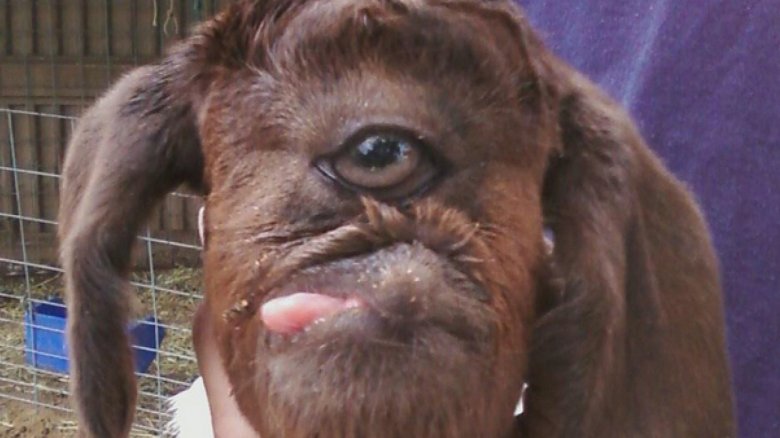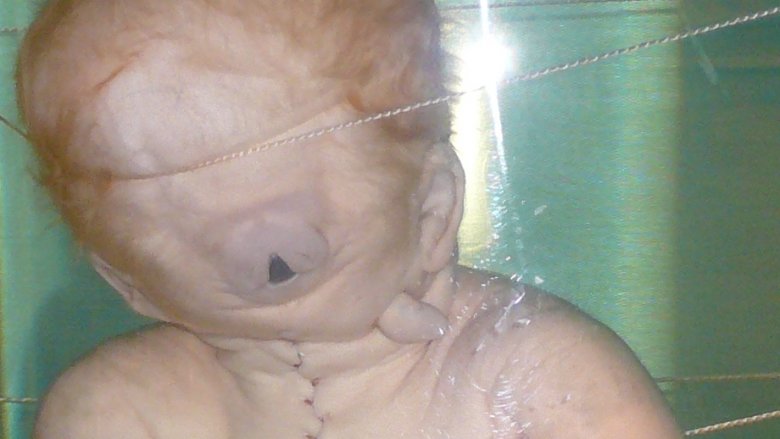The Truth Behind The Cyclops Goat
If you've seen this one-eyed goat frolicking around your social media feeds lately, you probably assumed it was a hoax and moved on with your life. Well, it isn't. It's very real. Here's everything you need to know about the cyclops goat.
The cyclops goat of India
According to National Geographic, there was a pretty remarkable birth in a village in Assam, India, on May 10, 2017: a cyclops goat. It has a rare condition called cyclopia (named after the cyclops of ancient lore) which occurs when the developing brain doesn't separate into two hemispheres. Only one eye socket forms, and you end up with a huge, kinda freaky eye in the middle of the head. Cyclopia is often caused when there are too many toxins present in the womb, but it can also happen if there's just some genetic wonk in the mix.
Because of other deformities that cyclopia causes, like malformed nostrils, animals with the condition don't usually live very long. That's what the owner of our little friend in India was told by local veterinarians. But the goat has proved everyone wrong and seems to be chugging along just fine. He's even gained some fans.
The cyclops goat is gaining a following
India might be the perfect place to be born if you're a cyclopic animal. In Indian-Hindu culture, animals, especially those with some kind of unique feature, are sacred. Having a one-eyed goat is cool enough, but having one that seems to be surviving and beating the odds makes it all the more awe-inspiring. Since this goat was born, it's become a sort of local attraction. According to its owner, Mukhuri Das, the goat is good luck, and others must believe this too since they're flocking to the goat in droves. Das said he's gotten dozens of daily visitors who want to see for the miracle kid for themselves. Das told National Geographic he believes the goat will "bring luck to his home." Here's hoping the little goat lives a long and happy life.
The origin of the cyclops
How did our fascination with one-eyed monstrosities start in the first place? Let's look at the fossil record. The ancient Greeks didn't have the knowledge of extinct species we have now, so when they discovered some old bones that didn't match anything they'd ever seen before, they got creative.
Such is the case with Deinotherium giganteum (translation: "huge terrible beast"). Today, we know that this guy was essentially a primitive elephant that once lived on the island of Crete. But because its enormous trunk left a huge hole in the middle of its skull, it's possible the Greeks found some fossils and mistook the pachyderm for a giant one-eyed monster. As far as turning real creatures into horrifying monsters go, the ancients did a pretty good job with that one.
The cyclops kitten
In 2006, an adorable ragdoll kitten was born in Oregon with — you guessed it — just one eye. "Cy" the kitten had holoprosencephaly which is the clinical term for the uber-rare congenital condition that can cause cyclopia. Combining a cuddly feline with a bizarre abnormality was viral gold in 2006, but that wasn't enough to save Cy, who lived only about 24 hours. Cy almost got to live a second life on display at a creationist museum in New York. According to the museum's owner, Cy's new purpose would be to foster debate about religion and science. We won't get into those questions, but we can say Cy would have been among the most intriguingly cute museum exhibits in history ... if the museum had ever opened. It hasn't yet and probably won't anytime soon.
The cyclops shark
In 2011, a fisherman in the Gulf of California made a somewhat unusual catch: a pregnant dusky shark. However, that wasn't the craziest thing he was in for that day. When he opened up the shark, he found a cyclops shark embryo looking back at him. The embryo was about 22 inches long and was the only cyclops of its nine siblings. The shark was then sent to the Interdisciplinary Center for Marine Sciences in La Paz, Mexico, for X-rays. (Scientists confirmed it was real and that it was definitely a cyclops.) It isn't the only shark of its kind, though. A few others have been discovered over the years, but they've all been embryos, probably because they'd have a hard time surviving in the wild.
The cyclops sheep of Idaho
One interesting case from the past actually sheds light on the cause of cyclopia. In 1957, a number of sheep in Idaho were giving birth to lambs with the condition. Because common sense tells us that probably shouldn't happen very often, the U.S. Department of Agriculture was called in to figure out what the problem was. For the next 11 years, top officials hung out in the wilds of Idaho trying to figure out what had gone wrong with that particular generation of sheep.
It took the efforts of a particularly determined researcher named Lynn James to figure things out. He really took the job to the extreme by spending three summers out in the fields with the sheep. As thrilling as that must have been, he discovered that the sheep were effectively doing it to themselves. The corn lilies they ate during droughts contained a poison. Later named cyclopamine after the birth defect it caused, the poison didn't hurt mother sheep but did harm their fetuses. But hey, cyclopamine might not be all bad! It's now being investigated as a possible treatment for tumors in humans. Thanks for taking one for the team there, sheep.
The cyclops goat of Texas
Our one-eyed friend in India isn't the only cyclops goat in recent years. The good ol' USA had its own for a little while back in 2012. Born in St. Lawrence, Texas, the cause of its condition was believed to be a hormone imbalance. This goat, however, had a twin with two normal eyes. Unfortunately, the Texan cyclops goat only survived about two weeks. In addition to its obvious eye problem, it was born with a deformed mouth and was unable to eat properly, owner Delmer Batla told the Midland-Reporter Telegram. Death wasn't the end for this one-eyed wonder: he later received new life between the covers of the 10th edition of the Ripley's Believe It or Not! book series, where most people probably don't believe it. (They should!)
Cyclopia in humans
Cyclopia can affect humans, too, but don't freak out. If you're reading this, you almost certainly don't have it. Thinking about raising your own little mini-people? Cyclopia affects just 1 in 13,000 live births, so the odds of your own child having it are pretty low. Unfortunately, humans with cyclopia typically don't live long because their hearts are usually fatally malformed. Since it's such an extraordinarily rare condition, there are very few examples of such children being born, and many recent examples have occurred in poorer countries where toxins that can cause the condition are far more common. There are very few cases from recent years that have caught the world's attention. A baby with cyclopia born in Nigeria in 2006 was pronounced dead ten minutes after birth, and an Egyptian baby born in 2015 may have developed cyclopia from radiation and was expected to die within a few days of birth.





